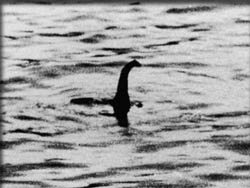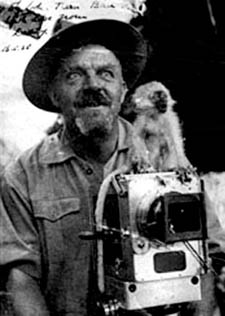Now there are several things which are not likely in the given account from the onset, but of particular interest is the supposed model which was said to have been photographed in this case. Below is an illustration of the model as it was described:
The Surgeon's Hoax
The most famous picture of the Loch Ness Monster, a grainy black and white photograph showing a long head and neck emerging from the lake, turned out to be a hoax.In 1993, Christian Spurling, stepson of the flamboyant movie maker and big game hunter "Duke" Wetherell, admitted he'd made the "monster" out of some plastic and a clockwork, tinplate, toy submarine. The picture (Often referred to as the "Surgeon's Photograph," because Colonel Robert Kenneth Wilson, a physician, claimed to had taken it by the Loch in April of 1934) had withstood careful scientific examination. Monster fans had speculated that the pictures showed a plesiosaur, while skeptics said it must have been an otter head or tree trunk. Nobody seems to have suspected it was actually a toy submarine.
Marmaduke WetherellTracking Down the StoryAccording to two Loch Ness researchers, David Martin and Alastair Boyd, in 1993 they'd heard Wetherell's son, Ian, in a 1975 article, had alleged that his father had faked one of the "Nessie" photographs. A couple of things seem to ring true about his statement. First he named Maurice Chambers as a part of the conspiracy. This was the very man Wilson had said he was going to visit the day he took photo. Also Ian Wetherell had mentioned that some of the photos taken that had been included the far shoreline in the image.Since, with only one exception, every version of the published pictures had the shoreline cropped out, it seemed likely that Ian only knew about it because he'd been there when the photo was taken.[No. There was still the one exception and that makes the statement unnecessary. DD] Since by then Ian Wetherell was dead, the two men decided to talk to Ian's stepbrother, Christian Spurling. When Martin and Boyd visited him, Spurling, then 93, admitted he'd been approached by Duke Wetherell to build a fake monster.Duke Wetherell apparently concocted the plan as revenge upon the London Daily Mail newspaper. In 1933 the Daily Mail had hired Wetherell to find the Loch Ness Monster. Soon after arriving at the lake Wetherell found some strange tracks of a four-toed creature in the soft mud near the water. Wetherell estimated that whatever left the tracks must be twenty feet in length. Plaster casts were taken and sent to the London Museum of Natural History. While the world awaited the Museum's analysis, however, hundreds of monster hunters and tourists showed up at the Loch. Unfortunately after a few weeks the Museum announced that the tracks were not that of an unknown monster, but those of a hippo. Apparently Wetherell himself had been hoaxed. The dried foot used to make the print was probably part of an umbrella stand or ash tray. The Daily Mail was angered at Wetherell and ridiculed and humiliated him.Wetherell's RevengeIt was soon after this that Spurling, who was a model-maker by trade, was approached by his stepfather to build the "beast." Construction was done with plastic wood over the conning tower of the toy submarine he'd purchased. The neck, estimated by some from the photograph to be over three feet high, actually measured (a stated) 12 inches."We'll give them their monster," Duke told his son. Ian Wetherell and his father took the completed contraption and a camera to the Loch and photographed it on a quiet bay, then sank the evidence in the mud at the edge of the lake. The undeveloped film was then passed to Chambers and on to Colonel Wilson, who had them developed. He then sold them photo to the Daily Mail. The conspirators were quite unprepared for the publicity the photo generated and apparently decided not to admit the hoax. The story stayed unknown for over sixty years.
http://www.unmuseum.org/nesshoax.htm

But in reality the construction would be very unstable, owing to the fact that it would be top-heavy without adequate bouyancy to keep it floating on an even keel and without adequate drag to hold the "heads-up" position. If placed in the water, it would tend to tip over because the center of gravity for the superstructure is forward of the center of buoyancy for the toy submarine holding it up (next two photos)
Beyond that simple fact, the story is full of many other holes. And the most glaring error was there were actually allegedly several photos taken but only two developed. This one was the best known of the two photos but the second photo was also published and it is in the book In Search of Lake Monsters by Peter Costello. And it is simply not possible for the same model to have been photographed a second time to have produced the second photograph.
Spurling was lying and the whole "Hoax" story is only a hoax itself.





"Now there are several things which are not likely in the given account from the onset, but of particular interest is the supposed model which was said to have been photographed in this case. Below is an illustration of the model as it was described".
ReplyDeleteBut that account does not come from Martin,Boyd, Spurling or Wetherell and neither does the illustration. They are straw men chosen to support your own argument. The photos of the Spurling model at Loch Ness were made with Ian Wetherell's Leica from which a print was then rephotographed with the plate camera given to Wilson. The "second" photo is just "another" photo,of an unknown object made at an unknown time and place, which was similarly rephotographed and placed in Wilson's camera.
Completely separate from the "Spurling model" story of 1991 from Martin and Boyd is the Mandrake "Wetherell model" article of 1975 and the Wilson "fake photo" admission in a letter from Major Eggington to researcher Nicholas Witchell in 1970.
That is surely enough to demonstrate that there was a hoax.
Bosh. You have misread and misconstrued the whole thing. If you look again you will see that the background article is offset and clearly marked from the Unmuseum. Kindly take your complaints there if you have issues with the account: I cannot be using them as strawmen for the simple reason I did not write it, and the article was not set up to discredit the men involved but to discredit the photo. In your eagernes to discredit me you have shown that you cannot even distinguish a clearly quoted section of offset print clearly credited to somebody else.
ReplyDeleteNow there is also no reason to support your reconstruction of events, while Spurling's story is all full of holes. I have dealt with the problem before. You do not have a leg to stand on, whether or not the photo is "Real" (PLEASE note that I never once say that it necessarily was!), SPURLING'S accountcannot be true and is a lie. Which is the main thrust above and remains unaltered. Spurling's "Confession to a hoax is itself a hoax, and moreover follows a folkloric pattern for "Confessions to hoaxes". They always use the same exact pattern, as this one does. So I'm afraid you're out of luck there.
"Spurling's story is all full of holes. I have dealt with the problem before. You do not have a leg to stand on,... SPURLING'S accountcannot be true and is a lie."
ReplyDeleteThank you for your reply. Could you kindly describe the holes and why his account cannot be true?
f course have to dig back through the older posts and get back to you. But I am not joking about Spurlings "Confession" conforming to a Folkloric pattern that is repeated feature-by-feature several times in other examples. I think I have that part pretty well nailed down. Few people realise that "Personal experience narratives" are largely Folkloric and indeed even Legendary in character. In this case, Spurling is given credit for what amounts to a popular legend. Ironically, it is also just about exactly the same for several other "I Hoaxed the Surgeon's Photo of the Loch Ness Monster" told with variations.
ReplyDeleteI had thought that there was another reply by Dick Raynor waiting to be published, but it turned out to be only another copy of his message of 15 January so I deleted it. The first time I made any comments on the matter on the CFZ blog has been reprinted on the next installment dealing with the Surgeon's photos: there shall be more following and now I also have a specific request to make some comments about the second Surgeon's photo taken at the same time on Loch Ness (We have the word of the pharmacist-developer that the two photos were together, and that there were other photos in the set which did not come out)
ReplyDelete